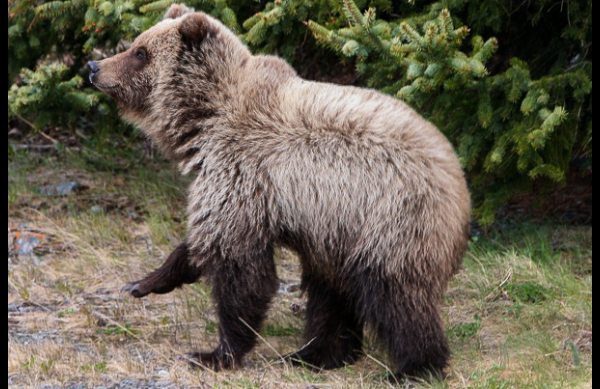Picture this. A brown bear saunters out of the brush along a highway. A car pulls over, followed by a pickup truck. Passengers jump out to take snapshots. They edge closer, crowding the bear, deriving comfort from numbers and their self-possessed superiority over other animals. Soon a bear jam is forming, with more vehicles veering off the road and more people snatching cameras and leaving common sense behind.
All of them have seen close-up footage of bears on television filmed by professionals with telephoto lenses. But these people are not professionals.
The scene I've described has happened multiple times in the past three weeks. The road is not in Yellowstone National Park. It's the Seward Highway, on the north side of Turnagain Arm, a few miles from Anchorage. And these people are not tourists. Judging from their license plates, most of them are us, the Locals.

The brown bear was recently seen near Rainbow. Jessy Coltrane and Dave Battle, wildlife biologists with the Alaska Department of Fish and Game, responding to a call for assistance from a park ranger, removed a dead dog from a wooded ditch between the parking lot and the highway. The dog, a Labrador retriever, had been shot and dumped in the ditch. Despite the ripe odor of decaying flesh, which surely attracted the bear, most of the earlier bear viewers seemed to be unaware that they were standing outside their vehicles between a brown bear and its lunch.
Suicide by cop is a colloquial term for what happens when a suicidal person deliberately threatens a law enforcement officer, provoking a lethal response. The phenomenon has engendered other clever expressions: death-by-cop, copicide, officer-assisted suicide, and victim-precipitated homicide.
What expression can we adopt for people who deliberately threaten a bear?
Most brown bear attacks are the result of a surprise encounter. Often the person is moving relatively quietly through an area with poor visibility. It's brushy or dark. The bear isn't paying a lot of attention. Or it has a young cub that can't move out of the way fast enough. Or the bear is feeding on a large carcass, like that of a winter-killed moose. And the person almost literally stumbles into the bear.
Surprise encounters are exacerbated by fast-moving people, runners and bikers. As horrible as they are to contemplate, bear attacks are rare.
But here we have the spectacle of a wad of people edging closer and closer to a brown bear feeding in plain sight along the Seward Highway.
People threaten bears. Think about it from the bear's perspective. You've been huddled in a den for six months without snacks. Now you're trying to mind your own business, grabbing a bite to eat from the vegetation that greens up first along the side of the road while you wait for a chance at the main course, the dead dog. And then along comes Mary. And Tom, Dick and Harry. All converging on your tiny bit of turf, moving deliberately closer. And closer.
Doesn't that seem a little threatening to you?
Close-range bear viewing and photography works in places like Katmai National Park and Preserve and McNeil River State Game Sanctuary where bears are somewhat habituated to people, at least in that setting. Rules in these dedicated bear-viewing areas actively discourage close approaches, bears are not allowed to obtain human food, and rangers or guides monitor the behavior of visitors and bears.
But this bear on Turnagain Arm is not habituated to people. There is no one on scene with the presence of mind or authority to tell everyone to step away from the bear. No one knew whether it had been fed by people and therefore might be tempted to approach or even break into a vehicle. It is the wildest of wild bears. It may tolerate humans up to a point, but every wild bear is surrounded by an invisible bubble. If someone steps inside the bubble, the bear will flee or charge.
Doug O'Harra witnessed defensive threats at one of the encounters. The bear was approached by at least a half dozen people. It became agitated and hop-charged one amateur photographer, huffing and warning him to back off. Another man circled uphill behind the bear and was bluff charged. The bear finally retreated back up the mountain.
And, in fact, this bear has eaten food handled by humans. Earlier in May, near Mile 111, it found a pile of salmon dumped near the highway and a can of salmon left open for bears to eat, according to Coltrane.
A series of long-range photographs taken by Helen O'Harra documented one of the scenes along Turnagain Arm. I see a loose phalanx of cars and pickup trucks. The bear is within feet of a compact sport-utility vehicle. People are smiling. I see one fellow, who appears to be reclining against the side of his pickup bed, pressing his point-and-shoot camera to his face a little more than a car length from the bear. If someone had startled the bear by making a loud noise or tossing a beer can at it, it could have dragged Mr. Point-and-Shoot down in less time than it took to focus his silly camera. I see a young mother in the crowd holding a large purse and balancing her one-year-old child on her hip.
Predictably, now there's talk of shooting the bear to protect the public. It's not afraid of people. It's getting too close to children.